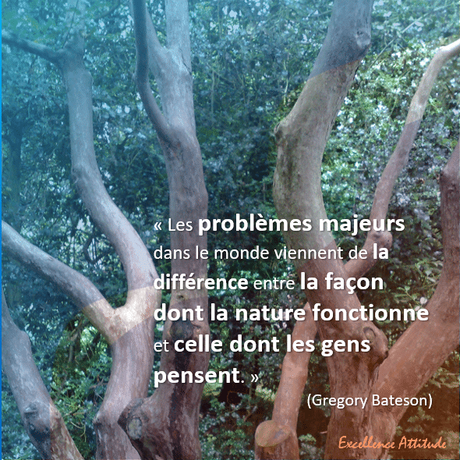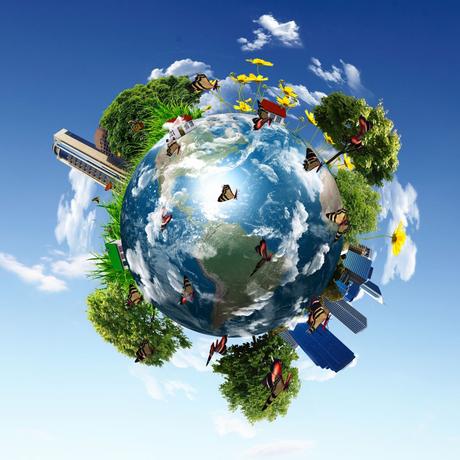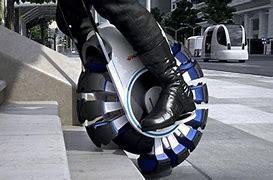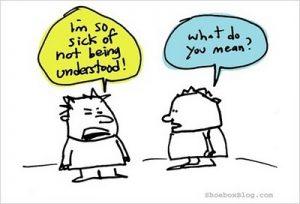In an earlier post, we explored some inadequate thinking models for mitigating global warming and enhancing sustainability. In this post, we explore how nature ¨thinks¨ about these aspects.
Perhaps it can help to create fresh ideas at the fundamental level of effective thinking routines.

The major problems in the world result from the difference between how nature works and the way people think.
George Bateson
Our human brain is capable of ingenious inventions but our powerful brain forgets that we are part of a biological ecosystem. Biomimicry is an approach where the focus is on us humans learning from and mimicking the strategies found in nature.
Problems related to global changes are complex. Nature and the living world are a complex system that are interconnected. We humans have divided up our society in different sectors, so it is difficult or even impossible to get an overview.
Nature is economical with the resources and uses few materials and minimal energy. In contrast, we humans often see materials as resources that we can harvest from nature. Nature has learnt to use minimal resources in creative and intelligent ways, while we based our thinking on an approach that are depleting Earth’s resources.

Nature uses “free energy” for example, sunlight, air currents, or water currents. Ecosystems soak up carbon dioxide and transform it into the building blocks of life. Since the start of the Industrial Revolution, humans have been releasing this compound into the atmosphere, contributing to climate changes. We see it as a major problem and we are still struggling to use it to.
Nature conducts life-friendly chemistry to carry out many of the tasks that we humans do. Yet, nature does this without using high temperatures, high pressures, harmful chemicals or chemical processes. One of the underlying problem that has contributed to the global changes is the use of fossil fuels to produce things like plastic. We carry several of our everyday tasks out using items that have been made using harmful chemicals, high temperatures, and pressures.
“Life can’t put its factory on the edge of the town, it has to live where it works.” Janine Benyus.
Chemicals are Man Made?
Robustness is a feature in both natural and artificial systems. Evolution might if given enough time select a robust trait that is tolerant against environmental perturbation. Robustness can also refer to the ability of a system to resist change. Human thinking is less flexible and robustness is often an either-or concept, for example, we either want a robust material or we do not. Nature strives to adapt to changes and a more robust organism is more adaptable.
Nature strives to create conditions conducive to the life of future generations. It is resilient but not always efficient, for example, we dispersed many plant seeds just to allow some to germinate. In contrast, we often focus human thinking on short-term solutions and efficiency. We are looking for solutions that will benefit us immediately and we have created systems are are efficient but may that lack resilience.
Some Solutions Inspired by Nature

From our post Tyres Inspired by Nature: The Flexup that explores ways that redesigned tyres to deal with obstacles that are present in cities, such as stairs. The Autobine is a self-driving bus concept where the number of passengers determines how many tyres that are going to be used.

From our post Innovations inspired by Nature: A Glowstone is exposed to light sources, the photoluminescent pigment within Glowstone becomes chemically excited and will afterglow (i.e. glow in the dark), initially strongly, then reducing slowly overnight. Pomegranates have inspired researchers at Stanford University to design a supercharged anode battery.
Design as Nature Would Design
We derive the next design principles from Janine Benyus´ 9 Basic Principles of Biomimicry. As she notes: “Learning about the natural world is one thing. Learning from the natural world—that’s the switch. That’s the profound switch.”

- The design runs on sunlight.
- It uses only the energy it needs.
- Its form fit to function.
- It recycles everything.
- It rewards cooperation.
- It banks on diversity.
- It demands local expertise.
- It curbs excesses from within.
- It taps the power of limits.
Nature’s Principles vs Human Thinking
- The design runs on sunlight, which in principle is an unlimited resource. The human design uses unlimited resources, for example, fossil fuels.
- Nature uses only the energy it needs while humans have an ever-increasing demand for energy.
- It fits form to function, for example, the wing shape of birds varies depending on the need of the bird. Often in human thinking economical and time factors are highlighted in the design process. It should be cheap and fast to build and construct items.
- Nature recycles everything, and waste products are used to create value for other organisms. Waste products from animals provide nutrients for plants and microbes. Humans have created a range of products using chemicals that cannot be recycled, for example, styrofoam cups.
- It rewards cooperation while human who are social species that relies on cooperation to survive and thrive, often rewards individuals rather than reward cooperation. Particularly the Western cultures can be seen as individualistic.
- Nature banks on diversity while humans think, for example, it is more efficient to grow a single crop, monoculture.
- It demands local expertise while humans rely on experts who might have an overall experience of the problem.
- Nature curbs excesses from within and the natural system has a tipping point that triggers a change. Forests renew and refresh. Humans do not think that excesses need to be curbed, for example, they see excess consumption of food or goods as an individual choice.
- It taps the power of limits while human strives to push the boundaries.
Brilliant Failures

Though, brilliant failures happen. The designers of Mercedes Benz’ Bionic Car looked at the boxfish from within known hydrodynamics, which failed to explain the boxfish´ movements. Apparently, they could not discover the design principle of the boxfish because the existing theories prevented them for noticing it.
Related posts
What Can a Forest Teach Us? A data management company skipped its year-end sales push and just like some animals in the forest they went into hibernation. They slowed down, took time to reflect and turned inward. The following year the sales increased by 20 per cent.
What can Nature Teach us about Money? We ask “What would nature do?” . Nature would be effective instead of efficient, resilient rather than rigid, relational instead of transnational, optimized rather than maximized.
Wild Innovation Approach. Darja Dubravcic´s Wild Thinking approach uses systems thinking and circular economy, biomimicry, and the empathy of human centered design together with creative techniques to develop and create products and services that are aligned to nature.
Robustness in Nature. We can learn from Mother Nature which is robust to Black Swans. It has reserves; the exact opposite of debt. We have two kidneys but an economist would say that is inefficient and that we should only have one. A mathematical economist would go further and say that we do not even need one, that we could store one in the center of London and use it when needed. But if unforeseen contingencies occur such as a bus or tube strike, then you would be in danger. It is better to have reserves.
Blue Economy. In contrast to Green Economy where the focus is on developing methods that are environmental friendly for the production of resources, Blue Economy strives towards getting rid of the need to use resource.
Mercedes Benz, Bionic Car, Boxfish and Thinking. Mercedes Benz’ engineers looked at the boxfish from within known hydrodynamics, which failed to explain the boxfish´ movements. Apparently, they could not discover the design principle of the boxfish because the existing theories prevented them for noticing it.
